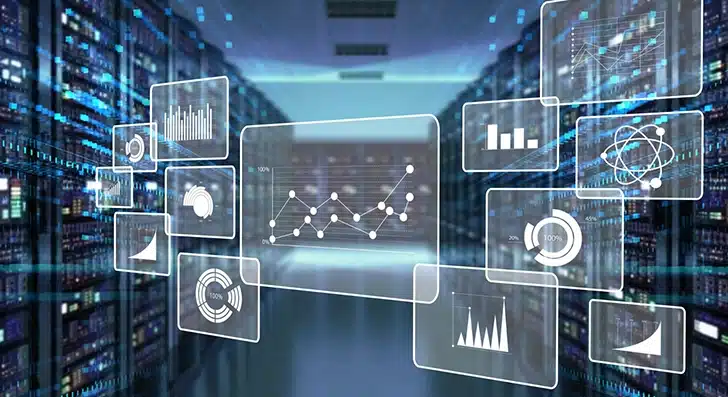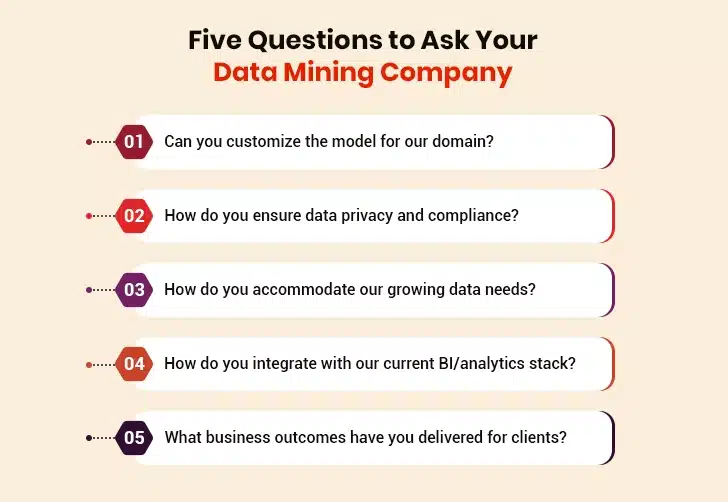Remember when Netflix suggested that perfect show you didn’t know existed? Or, when your bank called about a suspicious transaction before you noticed it? This isn’t just smart programming but the new age of predictive intelligence. It goes beyond simply mining through data for what happened yesterday to get a sneak peek into the future.
This change signals a key turning point. The gap between success and failure in a world churning quintillion bytes of data daily often boils down to a straightforward question: What’s coming next?
Instead of delving into past trends, business leaders are more interested in forward-looking insights to get ahead of competitors. As the stakes rise, the divide grows between companies that gather data and those that turn it into predictive intelligence. Therefore, professional data mining companies are also evolving.

Table of Contents
The Move from Historical Analysis to Predictive Intelligence
How Modern Data Mining Companies Are Changing
Key Capabilities to Look for in an Advanced Data Mining Model
Use Cases Spearheading the Predictive Intelligence Trend
Why Organizations Choose Data Mining Firms over DIY Approach
The Move from Historical Analysis to Predictive Intelligence
Traditional data mining methods required manual effort to clean, standardize, and prepare data. Data scientists spent most of their time on preparation before any actual mining could take place. While this method helped identify long-term patterns, it created an inevitable lag between events and the availability of insights. This impacted the leaders’ ability to respond in time-sensitive situations quickly.
Thankfully, technological advancements have made data mining more powerful, paving the way for real-time anomaly detection and pattern recognition. AI and machine learning have boosted mining capabilities by automatically detecting hidden patterns and complex relationships that human analysts may miss. Additionally, large language models (LLMs) have improved the scope of data mining to include unstructured text data. These models can extract insights from customer reviews, social media posts, chats, and more sources.
This change significantly impacts how business leaders use data. Instead of “What happened in the last quarter,” stakeholders want to know “What will happen in the next quarter?”. This forward-thinking approach drives strategic planning and proactive decision-making. The ability to forecast outcomes based on mined data has become a strategic advantage for businesses to outshine the competition. Owing to this imperative, data mining companies embrace technological disruptions to offer new capabilities.
“Where there is data smoke, there is business fire.”
– Thomas Redman, aka “The Data Doc”
How Modern Data Mining Companies Are Changing
Modern data mining service providers combine massive computational technology with advanced algorithms and industry-specific expertise. This convergence creates capabilities that were unimaginable just years ago. Thus, organizations can mine overwhelming data volumes and instantly uncover valuable insights. The main technologies driving this change are:
i. Integration with AI/ML and Cloud-Native Architectures
Leading data mining companies incorporate AI across their analysis workflows. These tools go beyond basic pattern recognition to identify hidden correlations and cause-effect relationships. Cloud-based systems provide the necessary computational power and scalability.
This combination allows for ongoing model training and improvement. Systems automatically include new data, ensuring accurate predictions, irrespective of the conditions. The cloud-based approach eliminates the limitations that earlier restricted mining and analytical capabilities.
Modern platforms have built-in tools to monitor how models perform over time. This constant validation ensures the model stays accurate and relevant. And when performance drops, the system starts retraining itself. Given the potential of AI technologies, 61% of organizations are evolving their data and analytics operating models.
ii. Use of AutoML, Graph Mining, and Anomaly Detection
Automated machine learning (AutoML) systems have democratized advanced data mining and analysis. These tools select the best algorithms and parameters for specific business challenges without human help, reducing dependence on scarce data experts.
Furthermore, graph mining techniques now analyze complex connections between entities. This approach reveals hidden relations and their impact within organizational data. The resulting insights enable more strategic choices. Anomaly detection systems spot unusual patterns to indicate opportunities and risks. Such capabilities help with equipment maintenance and customer behavior analysis, preventing fraud.
iii. Real-Time Web Data Mining and Unstructured Data Processing
Web data mining companies use advanced crawlers and parsers to extract information from online sources. This turns the Internet into a live data source for market intelligence. Organizations can analyze competitor strategies, understand customer sentiments, and discover new trends.
Advanced natural language processing models can extract meaning from unstructured content. They mine documents, conversations, social media posts, etc., to identify useful insights. This ability to analyze unstructured data significantly increases the amount of information available.
Visual analytics tools process images and videos on a large scale. This unlocks insights from previously hard to access visual data sources. Combined with text analysis, these tools provide a comprehensive understanding across multiple content types.
iv. APIs and Data Pipelines for Agility
Modern data mining platforms provide large API libraries to connect with existing systems. These interfaces allow seamless data exchange between applications, eliminating silos that previously limited analytical scope.
Automated data pipelines make collecting, changing, and loading data much simpler. These workflows operate continuously, so analysis always uses current information. This automation dramatically reduces the time between sourcing data and finding insights.
Furthermore, containerized deployment lets companies scale rapidly based on workload demands, helping them manage costs while maintaining performance. This agility empowers organizations to adapt to dynamic changes.
This is how data mining companies have evolved. They incorporate all the advanced technologies to harness the full potential of data and provide organizations with meaningful insights. However, choosing the right partner from plenty of options is challenging. This brings us to the next section: capabilities to look for in a data mining company.
Key Capabilities to Look for in an Advanced Data Mining Model
There’s no fixed way to establish any data mining model as the best, as every solution has unique capabilities and limitations. The right choice is a model that caters to business needs and objectives and aligns the outcomes accordingly. However, leaders and stakeholders must consider a few factors to make the right choice:
I.Domain-Specific Models
Data mining models designed for specific industries have deeper domain knowledge and understand context. These tailored approaches deliver better outcomes compared to generalized alternatives. They spot unique patterns and relations within specific business domains. Another best part is that domain-specific models require less training data and provide more accurate results. This works well in niche industries with limited historical data. The resulting predictions better reflect industry-specific trends and dynamics.
Leading providers maintain extensive libraries of models for common industry applications. These ready-made solutions accelerate implementation and value realization. Organizations can benefit from expertise gathered across multiple client engagements.
II. Scalable Infrastructure
Integrating the model with data platforms like Spark, Databricks, and Snowflake can help performance on a scale. These systems can handle huge datasets without slowing down processing. Thus, the resulting model supports even the most data-heavy applications. Additionally, cloud-based architectures allocate computing resources based on current demands. This dynamic scaling removes bottlenecks while optimizing costs.
Distributed processing capabilities divide complex analysis tasks across multiple compute nodes. This approach greatly reduces processing time for complex mining and analyses. Even the most sophisticated models provide results within operationally relevant timeframes.
III. Responsible AI and Data Ethics Frameworks
Ethical AI frameworks ensure algorithms are fair and prevent discriminatory outcomes. These guardrails maintain alignment with company values and regulatory requirements. Thorough testing helps identify and mitigate potential biases before model deployment.
Explainable AI capabilities offer transparency into how the model makes decisions. This helps stakeholders understand and trust what the model suggests. When a query arises, the system can articulate its thinking in a way humans can understand.
Regular audits on algorithms ensure they follow ethical standards. These reviews identify potential challenges before they impact business operations. The resulting documentation supports regulatory compliance and stakeholder communications.
IV. Data Governance and Security Posture
Robust security measures protect sensitive data throughout the mining and analysis process. These safeguards prevent unauthorized access while maintaining data utility. Encryption, access controls, and audit records ensure privacy rules are followed.
Data lineage tracking documents the source and change history of all information. This transparency helps ensure regulations and builds trust with stakeholders. So when queries arise, companies can show how they got their insights.
Privacy-preserving techniques, like differential privacy and federated learning, keep individual records safe. These methods provide valuable insights without putting personal information at risk. The results balance useful analysis with privacy protection.

Use Cases Spearheading the Predictive Intelligence Trend
Companies across industries are using predictive intelligence to solve previously intractable problems. The real-world applications go beyond theory to create measurable business value. The wide range of applications reflects the flexibility of modern predictive approaches. From improving customer experiences to boosting operational productivity, these examples show how foresight gives companies an edge in the real world:
1. Customer Experience: Churn Prediction and Retention Modeling
Advanced behavioral models identify at-risk customers long before they show signs of disengagement. These early alerts allow executives to intervene when retention efforts are most effective. Organizations shift from reactive responses to preventive engagement. They can also identify specific factors driving customers’ churn decisions and develop tailored retention strategies.
Predicting lifetime value helps prioritize retention efforts based on customer potential. This approach ensures maximum return on customer retention investments. Consequently, companies can dedicate resources to their most valuable customer relationships.
Another well-known predictive intelligence use case is dynamic recommendation engines. As the name suggests, these engines continuously adapt to user preferences and behavior. These systems suggest the most suitable choices at each interaction point, creating more intuitive experiences.
2. Operations: Flexible Pricing and Supply Chain Improvement
Real-time pricing models continuously adjust offers based on current market conditions. These systems maximize revenue while maintaining competitive positioning. Demand forecasting systems predict future needs with remarkable precision. This ability enables optimal inventory levels and resource allocation, helping businesses reduce storage costs while maintaining high service standards.
Supply chain optimization models identify potential disruptions before they impact business operations. This foresight lets companies take proactive measures and strategies to prevent issues and ensure continuity despite supply chains’ volatility. In short, companies can capture maximum value without losing market share.
3. Security: Fraud Detection and Risk Scoring
Real-time transaction monitoring helps identify suspicious patterns as they occur. These capabilities prevent fraudulent activities before the damage occurs. Behavioral analysis establishes normal patterns for each customer or entity. The system then flags deviations that might indicate fraud. This personalized approach greatly reduces false alarms while improving detection rates.
Network analysis reveals subtle connections between seemingly unrelated entities. These insights help uncover coordinated fraud attempts that span multiple accounts. Companies can identify and address entire fraud networks instead of single incidents.
Explore the Impact of Data Mining Across Industries in the Real World
Why Organizations Choose Data Mining Firms over DIY Approach
Data mining firms act as the enablers in helping organizations switch from traditional data analysis to predictive intelligence. They offer ready-to-deploy models, possess deep knowledge of industry-specific datasets, and provide proprietary algorithms. As a result, organizations are better positioned to reap the benefits of a proactive approach. Here’s a detailed look:
Time-to-Value with Plug-and-Play Models
One of the significant benefits of partnering with data mining providers are re-built solution accelerators that greatly reduce rollout time. Organizations get access to working solutions in weeks rather than months or years. Data mining firms also provide industry-specific templates that include tried-and-true methods and best practices. These foundations help avoid common implementation problems, leading to faster returns on investment and an edge over competitors.
Modular architecture enables customization without beginning from zero. Companies adjust standard parts to fit their unique needs. This method balances the advantages of standardization with the need to customize.
-
Expertise in Industry-Specific Datasets
Specialized data mining firms maintain extensive repositories of domain knowledge. This expertise helps organizations interpret findings in the right industry context. Moreover, access to industry benchmarks gives vital context for company performance. These comparisons highlight strengths and improvement areas, helping leaders better understand their positioning across key metrics and in the market.
The pool of skilled and experienced data professionals stays current with the industry shifts and new analytical methods. This ongoing learning ensures mining techniques remain current and effective. As a dual benefit, stakeholders benefit from external perspectives and cross-industry insights.
-
Competitive Edge from Proprietary Mining Techniques
Proprietary algorithms perform better than open-source alternatives. These specialized approaches address specific business challenges with greater accuracy. Additionally, ongoing research and development ensure mining and analytical tools remain relevant. Thus, organizations can benefit from innovation without spending on internal R&D. Taking the models a notch higher, custom feature engineering boosts their performance for specific business contexts. These specialized inputs improve prediction accuracy and reliability.
Wrapping Up
The shift from historical pattern recognition to predicting future trends changes the way organizations use data. This foresight is a critical differentiator, enabling businesses to make proactive decisions and remain competitive. And choosing the right data mining company plays a key role in this revolution. Organizations must develop strategies to capitalize on these capabilities as predictive intelligence evolves.
The ideal partnership brings technical expertise, industry insights, and proven delivery capabilities. This accelerates value realization while reducing implementation risks. To sum up, data mining companies act as enablers in helping organizations leverage predictive intelligence capabilities and turn data into useful forecasts that guide their choices.





